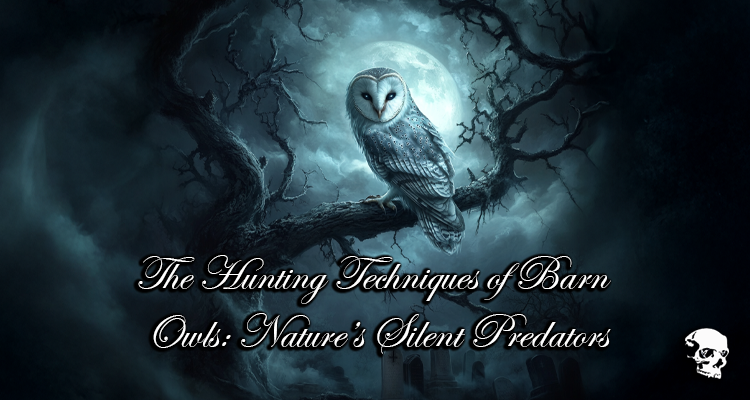Currently Empty: $0.00

The Hunting Techniques of Barn Owls: Nature’s Silent Predators
Barn owls (Tyto alba) captivate the imagination with their ghostly appearance, ethereal silence, and predatory prowess. Revered in folklore and often symbolizing mystery, these nocturnal hunters dominate their ecosystems with a combination of innate skill and anatomical design. While their haunting calls and moonlit silhouettes might evoke a sense of the otherworldly, it is their unparalleled hunting strategies that set them apart as masters of the night. From soundless flight to precision strikes, barn owls epitomize nature’s unyielding efficiency, offering insights into the delicate balance of predator-prey dynamics.
Acoustic Precision: Hunting in Darkness
One of the barn owl’s most remarkable hunting adaptations is its ability to locate prey purely through sound. Unlike many predators that rely on sight, barn owls excel in pitch-black conditions, leveraging their asymmetrical ear placement to detect the faintest rustles of movement. This asymmetry allows each ear to capture sound from different angles and depths, enabling the owl to create a three-dimensional “auditory map” of its surroundings.
The owl’s facial disc—a concave arrangement of feathers surrounding the face—further amplifies and directs sound toward its ears. These unique adaptations allow barn owls to detect and pinpoint prey with uncanny precision, even beneath layers of snow or dense vegetation. This auditory mastery ensures they remain effective hunters regardless of light availability, a skill vital to their survival in diverse environments.
Silent Wings: The Art of Stealth
A barn owl’s flight is a masterpiece of natural engineering, enabling it to approach prey without a whisper of sound. Unlike most birds, barn owls possess feather fringes along their wing edges, which break up turbulence and reduce noise. This unique feather structure, coupled with soft, velvety plumage, absorbs sound, ensuring that their movements remain undetectable.
This silent flight is not merely a function of feather anatomy; the owl’s broad wings and lightweight body allow it to glide effortlessly, reducing the need for energy-intensive flapping. The combination of these traits creates a predator that strikes with the quiet inevitability of a shadow, an apt metaphor for its ghostly persona.
Precision Strikes: A Deadly Ballet
Once a barn owl identifies its prey, it transitions from silent observer to deadly executioner. Its approach is a calculated blend of speed and stealth, with a dive that combines both precision and power. Barn owls often hover momentarily before striking, allowing them to fine-tune their trajectory. This technique is particularly effective when targeting prey hidden in dense underbrush or snow, as the owl’s talons penetrate deep to grasp its quarry.
Interestingly, barn owls demonstrate remarkable adaptability in their strikes. While stationary prey is their preferred target, they are capable of adjusting mid-flight to capture moving animals. This ability to recalibrate, based on the speed and direction of their target, underscores their sophistication as hunters.
Behavioral Adaptability: Flexibility in Action
Barn owls showcase impressive behavioral flexibility in their hunting methods. While predominantly nocturnal, they can hunt during the day when circumstances demand, such as feeding hungry chicks or when food sources are scarce. This occasional diurnal hunting reveals their ability to adapt to environmental pressures, a trait that enhances their resilience as a species.
Their hunting behavior also reflects an acute understanding of their environment. Barn owls often exploit human-altered landscapes, such as farmland, where rodent populations thrive. This opportunistic behavior not only ensures a steady food supply but also highlights their role in controlling pest populations.
Anatomy of Efficiency: The Tools of the Trade
The barn owl’s hunting prowess is deeply rooted in its unique anatomy. Its wings are long and cambered, designed for slow, controlled flight—essential for stalking prey undetected. The owl’s talons, sharp and curved, are perfect for grasping and immobilizing small animals.
Beyond physical attributes, barn owls possess acute physiological adaptations. Their exceptional vision allows them to detect movement even in low-light conditions, complementing their auditory skills. This synergy between sight and sound creates a predator finely tuned to its nocturnal hunting lifestyle.
The Ghost of the Fields: Habitat and Prey Adaptations
Barn owls thrive in a variety of habitats, from open fields and forests to agricultural lands. Their adaptability extends to their prey preferences, which include rodents, small birds, and insects. In human-dominated landscapes, barn owls are often seen as allies, controlling rodent populations and maintaining ecological balance.
Notably, barn owls can traverse vast distances in search of food, even crossing water to reach isolated islands. This ability to exploit diverse terrains underscores their resilience and resourcefulness, qualities that have allowed them to flourish across continents.
The Dark Symphony: A Symbol of Elegance and Survival
Barn owls embody the quiet beauty of nature’s design, moving through the darkness with a grace that defies explanation. Their hunting techniques are a testament to the harmony between form and function, a blend of anatomical perfection and behavioral ingenuity. By mastering their environment and refining their predatory skills, barn owls have earned their place as one of nature’s most effective hunters.
Their silent ballet in the moonlit skies serves as a poignant reminder of the balance between life and death in the natural world. In their ethereal presence, we find a reflection of the mysterious elegance that defines the nocturnal landscape, a fitting tribute to creatures that live in the shadows yet leave an indelible mark on their environment.
Are you enjoying this article or our site? Love of Gothic and the Dark Matters & Mischief magazine are run by dedicated volunteers, and we rely on crowdfunding to cover our expenses. Your support is crucial to keep us going! Consider becoming a paying member of our Patreon or purchasing something from our shop to help us continue providing content and community support. Thank you for your support!

